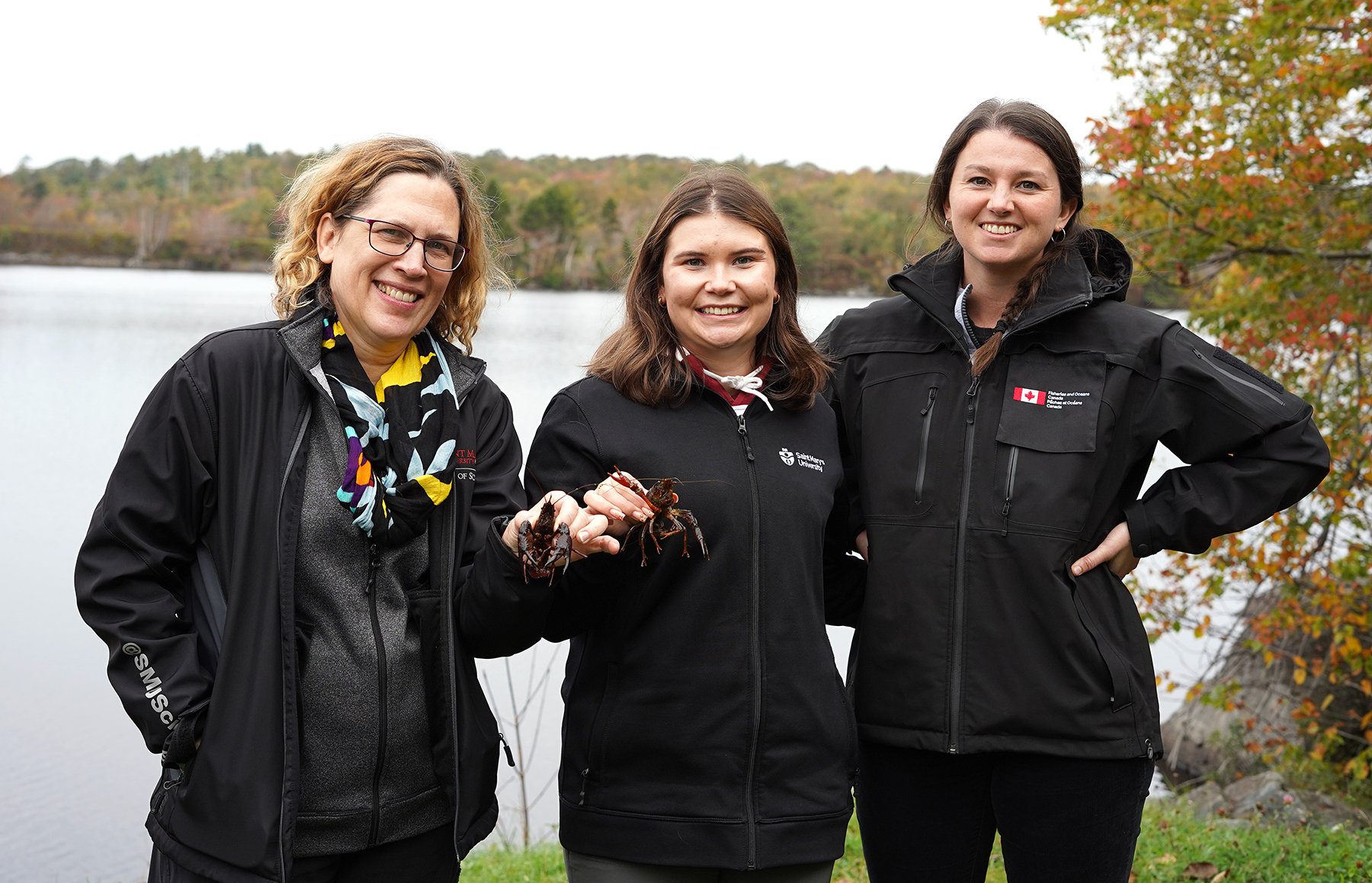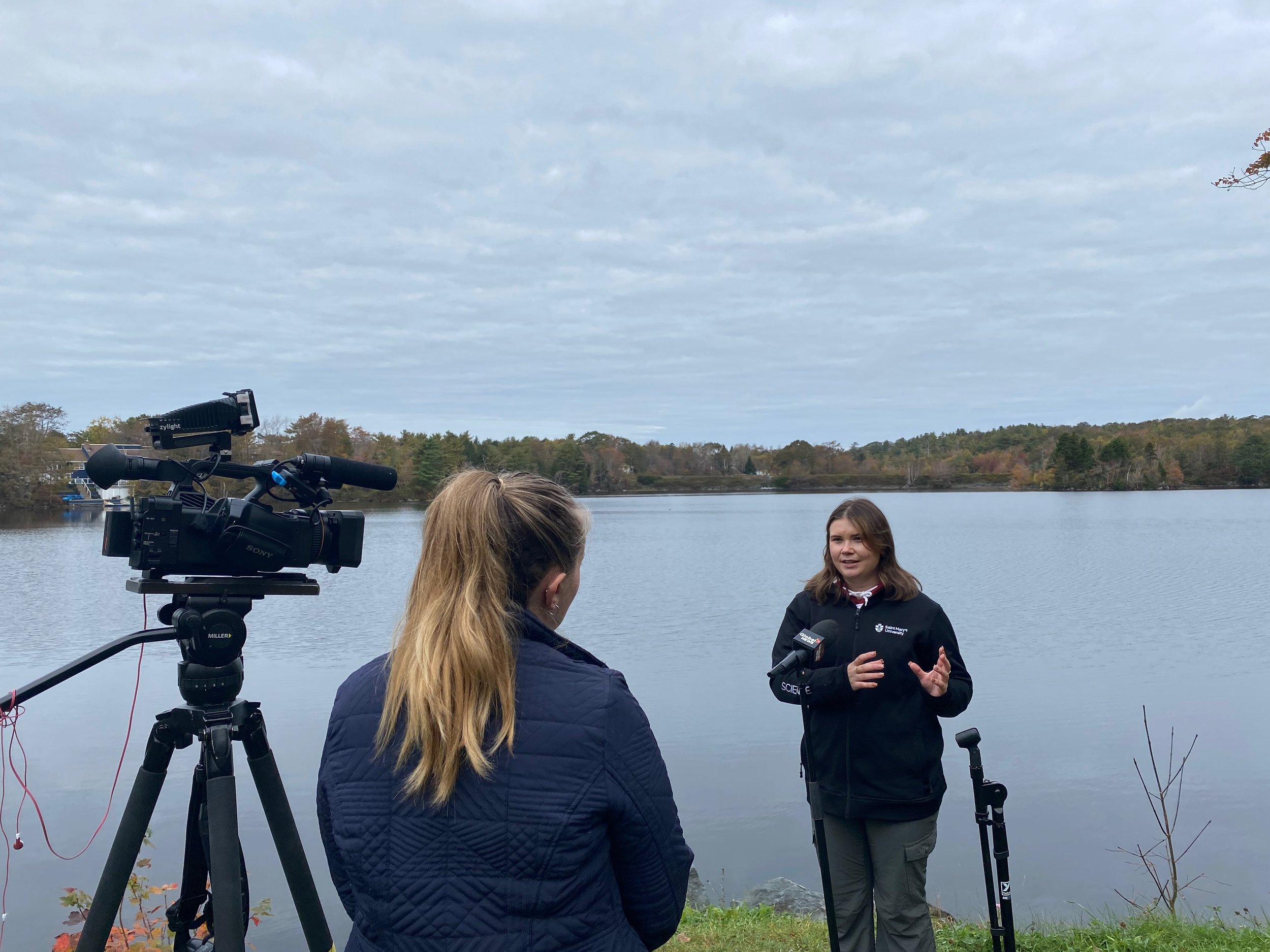Invasive species has potential to move well beyond one Halifax-area lake
Dr. Linda Campbell, graduate student researcher Madison Bond, and DFO Officer Sarah Kingsbury MSc’20 show evidence of crayfish at Three Mile Lake
As a master’s student at Saint Mary’s University, Madison Bond has a unique and exciting opportunity to conduct research that could play a pivotal role in the protection of Nova Scotia’s ecosystem.
For her thesis project, she has been studying the presence of Red Swamp Crayfish, an invasive species found in Three Mile Lake, in Waverley, N.S. This species has the potential to wreak havoc on this lake—with the potential to create damage on a much larger scale.
Red Swamp Crayfish, which look like tiny lobsters, are native to the southern United States. It’s not known yet how they arrived in the Maritimes, but Madison, along with supervising professor Dr. Linda Campbell and partners at the Department of Fisheries and Oceans Canada (DFO), have been investigating the impact that they have already had on the lake.
Madison Bond speaks with media about her research
Under a student contract with DFO, Madison caught the first live crayfish at the lake in 2022; approximately 100 have now been captured in traps. Her research work this academic year and next summer is to collect more crayfish and study how their lifecycle and habits differ compared to the crayfish living in their native habitats.
Because Nova Scotia temperatures are colder than their native freshwater habitats, crayfish may burrow deeper into shorelines. The temperature could also affect the number of offspring and the length of their lifecycle. Using frozen crayfish in the lab, Madison will also determine what they eat—leading to more answers about their impact on the local ecosystem.
As an invasive species in a lake, crayfish cause a variety of issues. Crayfish are known for burrowing into the shoreline, which can cause significant damage by changing the shoreline which leads to erosion. Along with the loss of habitat for native species, the aggressive crayfish also compete for food, space and calcium in the water.
Crayfish go through a wandering phase in their lifecycle, which means that they can travel significant distances on land, and potentially move to new bodies of water. The Shubenacadie Canal is within walking distance for a crayfish, meaning this invasive species problem has the potential to become exponentially larger. “Shubie” Canal is a 114-kilometre waterway that stretches from the Halifax Harbour to the Bay of Fundy, and is a well-used and loved recreation destination in Nova Scotia.
Crayfish aren’t the first invasive species in Nova Scotia. Dr. Linda Campbell’s Dynamic Environment and Ecosystem Health Research (DEEHR) lab at Saint Mary’s has also investigated the impact of two other invasive species, Chinese mystery snails and chain pickerel.
To protect the province’s native species, habitats and waterways, never introduce a plant, pet or other animal into the wild.
If you find a crayfish, please put it in a bag and note details such as location coordinates, time and date, and contact Madison Bond and the team at Saint Mary’s who will collect it from you. Please do not disturb the traps.
Public Lecture
Dr. Linda Campbell will present a lecture titled “Overlooked no more: non-indigenous, invasive species in Nova Scotia lakes & rivers”
The unanticipated and unplanned appearance of non-indigenous species in freshwater ecosystems is a global issue. In regions lacking biosurveillance and awareness programs, the potential for unwanted species to establish in lakes is very high. Dr. Linda Campbell will present case studies for both fish and invertebrates in Nova Scotia, highlight progress made over the past decade, and discuss ongoing needs in order to limit the impact of unwanted species on Nova Scotia’s freshwater ecosystems.
Date: Monday, December 4, 2023
Time: 7:30 p.m.
Location: In person at Saint Mary’s University – Atrium 101 or via Zoom
Details: https://nsis1862.ca/public-lectures/



